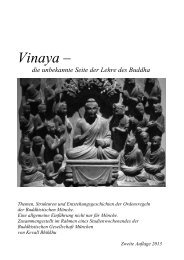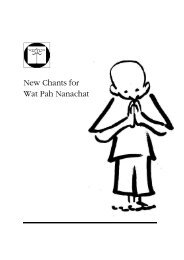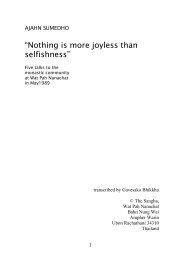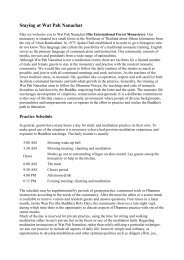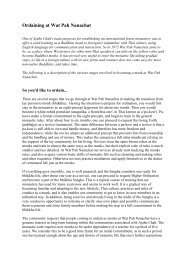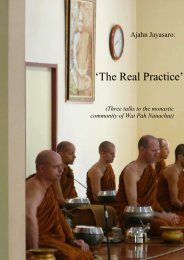Luang Por Liem: The Ways of the Peaceful - Wat Pah Nanachat
Luang Por Liem: The Ways of the Peaceful - Wat Pah Nanachat
Luang Por Liem: The Ways of the Peaceful - Wat Pah Nanachat
You also want an ePaper? Increase the reach of your titles
YUMPU automatically turns print PDFs into web optimized ePapers that Google loves.
espectful starts to feel smoo<strong>the</strong>r and smoo<strong>the</strong>r, and <strong>the</strong> sitting<br />
posture doesn’t make it feel like you are straining <strong>the</strong> leash any<br />
more. One can do <strong>the</strong>se things if one keeps exercising oneself.<br />
<strong>The</strong> training <strong>of</strong> all <strong>the</strong>se external aspects is necessary. One<br />
needs to rely on <strong>the</strong> continuity <strong>of</strong> one’s efforts. In <strong>the</strong> end one is<br />
able to do things. <strong>The</strong> reason for such practices is because, in<br />
keeping to our intentions as monks, we want to take on a life <strong>of</strong><br />
simplicity. To sit on <strong>the</strong> floor, for example, is plain and simple,<br />
because <strong>the</strong>re is no need to arrange <strong>the</strong> place with objects to sit on<br />
or cushions to support one, just like in those places that <strong>the</strong><br />
Buddha considered to be simple dwellings 21 . <strong>The</strong> Buddha wanted<br />
us to live in a way where we develop an attitude that is orientated<br />
towards nature. This is an important aspect.<br />
We need to train and develop in our practice. Any aspect <strong>of</strong><br />
<strong>the</strong> practice relies on training, on doing things over and over.<br />
<strong>The</strong>re are certain qualities in <strong>the</strong> life <strong>of</strong> an anagarika, one who<br />
isn’t bound to a home, that <strong>the</strong> Buddha called treasures. <strong>The</strong>y are<br />
valuable goods. You probably know some <strong>of</strong> <strong>the</strong>m. One <strong>of</strong> <strong>the</strong>m<br />
has to do with our body – it is what <strong>the</strong> Buddha called<br />
kayasamvara, restraint <strong>of</strong> <strong>the</strong> body. It concerns our bodily<br />
behaviour. Possessing restraint towards <strong>the</strong> body helps us to see<br />
things clearly, because our attention needs to be connected to our<br />
bodily movements, activities and <strong>the</strong> respective feelings in each<br />
posture. We need to directly know <strong>the</strong>se things in time, and – for<br />
<strong>the</strong> sake <strong>of</strong> restraint – we also need to be able to tell right away<br />
whe<strong>the</strong>r each bodily action or movement is appropriate for an<br />
21 e.g. living at <strong>the</strong> root <strong>of</strong> a tree, out in <strong>the</strong> open, or in empty houses, as<br />
mentioned in <strong>the</strong> thirteen ascetic practices allowed by <strong>the</strong> Buddha.<br />
55



